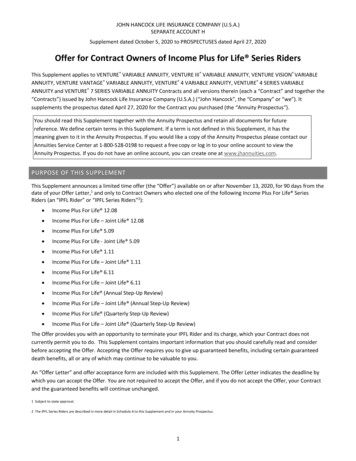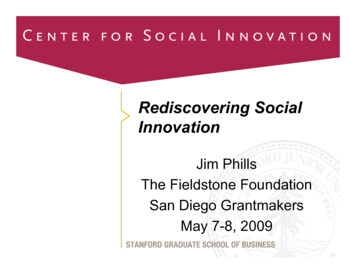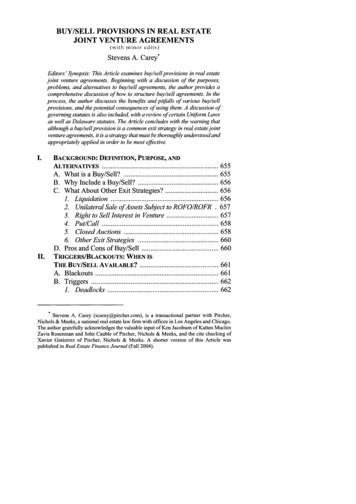
Transcription
NBER WO GPAPER SERIESTHE GOVERNMENT AS VENTURECAPITALIST: THE LONG-RUN IMPACTOF THE SBIR PROGR4MJosh LemerWorking Paper 5753NATIONAL BUREAU OF ECONOMIC RESEARCH1050 Massachusetts AvenueCambridge, MA 02138September 1996I thank Fran Featherston, Lowell Mininger, and Mark Nadel of the U.S. General Accounting Officeand Jesse Reyes of Venture Economics for access to data; Horace Crouch and Robert Wrenn of theU. S, Department of Defense for assistance in arranging interviews with awardees; and LewisBranscomb, Ken Flarnm, Paul Gompers, Adam Jaffe, Scott Wallsten, and seminar participants at theNBER Science and Technology Policy Meeting and Harvard Business School for helpful comments.Chris Allen, Mannie Liu, and Kathleen Ryan provided research assistance. I thank the Center forScience and International Affairs at the Kennedy School of Government and the Division ofResearch at Harvard Business School for financial support. This paper is part of NBER’s researchprogram in Productivity.Any opinions expressed are those of the author and not those of theNational Bureau of Economic Research.O 1996 by Josh Lemer, All rights reserved. Short sections of text, not to exceed two paragraphs,may be quoted without explicit permission provided that fill credit, including 0 notice, is given tothe source,
NBER Working Paper 5753September 1996THE GOVERNMENT AS VENTURECAPITALIST: THE LONG-RUN IMPACTOF THE SBIR PROGR4MABSTRACTPublic programs to provide early-stage financing to firms, particularlyhigh-technologycompanies, have become commonplace in the United States and abroad. The long-run effectivenessof these programs, however, has attracted little empirical scrutiny. This paper examines the impactof the largest U.S. public venture capital initiative, the Small Business Innovation Research (SBIR)program, which has provided over 6 billion to small high-technology firms between 1983 and 1995.Using a unique database of awardees compiled by the U.S. General Accounting Office, I show thatSBIR awardees grew significantly faster than a matched set of firms over a ten-year period.Thepositive effects of SBIR awards were confined to firms based in zip codes with substantial venturecapital activity.The findings are consistent with both the corporate finance literature on capitalconstraints and the growth literature on the importance of localization effects.Josh LemerGraduate School of Business AdministrationMorgan HallHarvard UniversitySoldiers FieldBoston, MA 02163and NBERjlemer@hbs.edu
1.IntroductionThe federal government has played an active role in financing new firms, particularly inhigh-technology industries, since the Soviet Union’s launch of the Sputnik satellite. In recent years,European and Asian nations and many U.S. states have adopted similar initiatives.programs’precise structuresassumptions:have differed, the efforts have been predicatedWhile theseon two shared( that the private sector provides insufficient capital to new firms, and (i) that thegovernment can identify firms where investments will ultimately yield high social and/or privatereturns.’ These claims have, however, received little scrutiny by economists.2lIt is striking to note the similarities between, for instance, the statement of Senator JohnSparkman [1958] upon the passage of the Small Business Investment Act and the recent testimonyof Dr. Mary Good, Under Secretary for Technology at the U.S. Department of Commerce [1995].The rationales for such programs are discussed in depth in U.S. Congressional Budget Office[1985].2While both government agencies and academic economists have sought repeatedly to assess theefficacy of federal programs to aid technology-intensive industries, they have tended to focus ondifferent questions. Most federal evaluations of these programs have consisted of case studies andExamples of suchsurveys of the commercial activity directjy attributable to the awards.evaluations of the SBIR program include Myers, Stem, and Rorke [1983], Price, Waterhouse[1985], and U.S. General Accounting Office [1987a, 1989, 1992]. Surveys of direct commercialimpacts are subject to several biases. For instance, in the case of the SBIR program, small businessadvocates conducted a protracted lobbying campaign to expand the program. Executives active inthis effort may have overstatd the benefits from the awards. At the same time, some firms hadreasons to downplay the commercial benefits of the program. During the early 1990s, a number ofpharmaceutical and biotechnology companies that developed research originally funded by theFirms that received spectacularNational Institutes of Health were intensely scrutinized.commercial benefits from the SBIR program may have been reluctant to acknowledge them, lestthey attract unwelcome attention from reporters and politicians.Finally, because many firmspursued SBIR projects closely related to their core technologies, determining the direct impact ofan SBIR award may have been difficult. Studies of federal technology programs by academiceconomists, beginning with Levy and Terleckyj [1983], have tended to focus on the short-runeffects of these effofis. In particular, they ask whether federal finds substitute for or stimulateprivate R&D spending.For instance, Irwin and Klenow [1994] show that semiconductormanufacturers substantially reduced their own R&D spending while participating in the Sematech1
The neglect of these questions is unfortunateWhile the sums of money involved aremodest relative to public expenditures on defense procurement or retiree benefit% these programssurnmarizedin Tablel—arevery substantialwhen comparedto contemporaneousprivateinvestments in new firms. For instance, the Small Business Investment Company (SBIC) programled to the provision of more than 3 billion to young firms between 1958 and 1969, more than threetimes the total private venture capital investment during these years (Noone and Rubel [1970]). In1995, the Small Business Innovation Research (SBIR) program provided almost 900 million toyoung technology-intensivefirms.This was about equal to the annual rate of early-stageinvestments by venture capitalists in recent years (Venture Economics [1996], U.S. Small BusinessAdministration[1996]). Some of America’s most dynamic technology companies received supportthrough the SBIC and SBIR programs while still private entities, including Apple Computer,Chiron, Compaq, Federal Express, and Intel.Public venture capital programs have also had asignificant impact overseas: for instance, these programs have accounted for more than one-half ofthe recent investments in new German technology -intensivefirms(Wupperfeld [1992]).The recent economic literature suggests reasons to be both optimistic and skeptical aboutthe efficacy of public venture programs.On the positive side, a growing body of writing suggeststhat new firms, especially technology-intensiveones, may be receiving insufficient capital.Theliterature on capital constraints (reviewed in Hubbard [1996]) documents that an inability to obtainexternal financing limits many forms of business investment.Particularly relevant are works byconsortium. Wallsten [1996] shows that the subset of SBIR awardees that were publicly tradedreduced their own spending on R&D in the years immediately following the award.2
Hall [1992], Hao and Jaffe [1993], and Himrnelberg and Petersen [1994]. These show that capitalconstraints appear to limit research-and-developmentexpenditures, especially in smaller firms. Itmight be thought that these effects would have been particulady strong during the 1970s and early1980s, when the venture capital pool was relatively modest in size. As the first panel of Table 2reports, the pool of venture capital fidshas grown dramatically in recent years.This has beenlargely due to the relaxation of the regulations and informal curbs that precluded many pensionfinds from investing in this asset class (Fenn, Liang, and Prowse [1995]). The capital constraintsliterature suggests that public awards to high-technologyfirms should be associated with significantgrowth, as firms pursue value-creating projects that they would otherwise be unable to finance?On the opposing side, the corporate finance literature highlights the importance of privatemechanisms to finance young, high-growthfirms.The dominant form of financing is venturecapita which accounts for about two-thirds of the external equity financing raised from pnvatesector sources by privately held technology-intensivebusinesses(Freear and Wetzel [1990]).Venture investors frequently disburse finds in stages. Managers of these venture-backed firms areforced to repeatedly return to their financiers for additional capital, in order to ensure that themoney is not squandered on unprofitablemonitor managers.and representationprojects.In addition, venture capitalists intensivelyThese investors demand prefemed stock with numerous restrictive covenantson the board of directors.(Various aspects of the oversight role played byprivate equity investors are documented in Gompers [1995], Lemer [1995], and Sahlman [1990];3A related body of literature documents that investments in R&D yield high private and socialrates of return (e.g., Griliches [1986], Mansfield, et al, [1977]). These findings similarly suggestthat a higher level of R&D spending would be desirable.3
the theoretical literature is reviewed in Barry [1994].) Government officials are unlikely to have theexpertise or resources to effectively monitor entrepreneurs.Consequently,even if an award ofpublic finds to an entrepreneurial firm leads to a short-run expansion in activities, the increase isunlikely to be sustainable.The academic literature also differs in its predictions of where public grants will have thegreatest impact.Venture capital financing is concentrated in particular regions and sectors.Thesecond and third panels of Table 2 document this pattern, showing the distribution of early-stageventure financingby state and Standard Industrial Classification(SIC) code between 1983 and1985 (the period in which the SBIR awards under study in this paper were made).concentrationsotiareof awards in California and Massachusetts,Theas well as in computer hardware andsectors, is apparent.This concentration can be interpreted in two ways. On the one hand, several models arguethat institutional investors frequently engage in “herding”: making investments that are too similarto one another. These models suggest that a variety of factor forassessed on a relative, not an absolute, basis-canmaking too similar investments.instance, when performance islead to investors obtaining poor performance by(Much of the theoretical literature is reviewed in Devenow andWelch [1996]; Sahlman and Stevenson [1986] present a case study suggesting such behavior byventure capitalists)These models suggest that public investments4in sectors and regions less
heavily supported by venture capitalists might lead to superior returns, because value-creatinginvestments in less popular areas may have been ignoredOn the other hand, recent models of economic growtbbuildingeconomic geographers-havemay be very concentrated.on earlier works byemphasized powerful reasons why successful high-technologyfirmsThe literature highlights several factors that lead similar firms to clusterin particular regions including knowledge spillovers, specialized labor markets, and the presence ofcritical intermediate good producers(The theoretical rationales for such effects are summarized inKrugman [1991 ].) Case studies of the developmentof high-technologyregions (e.g., Saxenian[1994]) have emphasized the importance of intermediaries such as venture capitalists, lawyers, andaccountants in facilitating such clusteringIf these effects are important, and the supply of venturecapital was restricted as discussed above, then we might expect public awards to have particularimpact if they were dispersed in the same regions as independent venture capitalists invested.This analysis assesses the long-run success of firms participating in the largest U.S. publicventure capital initiative the SBIR program.firms. ApproximatelyI examindthe employment and sales growth of 1135half of the sample received one or more awards of approximately one-halfmillion dollars in the first three cycles of the SBIR progra the other half were matching firmsconstructed to resemble the SBIR awardees as closely as possible. In order to assess the program, Irelied heavily on a unique longitudinaldata-set of awardees compiledAccounting Office (GAO).5by the U.S. General
One decade later, the SBIR awardees have enjoyed substantially greater employment andsales growth than the matching firms. This superior performance, however, was not universal. Thedifferentials in both employmentand sales growth were confined to firms in zip codes that weresimultaneously the site of substantial venture capital activity. The SBIR awards appear to have hadmuch less impact on the performance of firms in other regions. The awards contributed both to thegrowth of firms that were or were not backed by venture capital, and that were or were not inindustries heavily financed by venture capital.Some evidence suggests that the positive impactwas strongest for firms in areas with many venture investments but in industries not frequentlyfinanced by venture capitalists.While the superior long-run performanceof the SBIR awardees is consistent with thepresence of capital constraints, it is clearly not the only interpretation.lead to the identification of firms with superior long-run prospectsmight make no difference.The selection process mightThe provision of funds itselfAlternatively, the selection of a firm for an SBIR award might serve asa favorable signal to potential customers and investors.In other words, the results are consistentwith the second claim of the first paragraph of the introduction being true, but the first claim notbeing true.To address this concern, I employed two sets of matching firms: one set with noparticipation in the SBIR program; the other which received at least one much smaller, but highlycompetitive,preliminarySBIR awmd (termed Phase I awards).If the SBIR awards simplyidentified superior firms, and the capital provided did not make a difference, I anticipated that the6
long-run success of the Phase I awardees would be consistentlygreater than that of the non-awardees. The fact that the growth of these two sets of matching firms did not materially differfrom each other—both lagged the performance of recipients of the fill SBIR awardesuggestedthat the capital provided was importantThe results are also robust to controls for the hypothesisthat SBIR awardees grew because they established relationships with federal officials or politicians,which led to procurement contracts.These findings are relevant for several reasons.First, they are consistent with both thecorporate finance literature on capital constraints and the growth literature on the importance oflocalization effects.Second, they provide guidance as to what types of public venture programsare likely to be effective.In particular, they underscore doubts about recent federal efforts toencourage the formation of venture finds investing in economicallyabroad. Finally, the findings are relevant to the intensi ingprogram itself.While the results cannot be unambiguouslythe arguments of universitydistressed areas here andpolicy debate surrounding the SBIRinterpreted, they call into questionand medical center administrators(summarizedin Mervis [1996])that the program has not produced any economic benefits.The plan for the paper is as follows.In Section 2, I review the structure of SBIR awards,and why they may address the financing needs of smaller firms.The third section describes thedata set. Section 4 presents the analysis, and the final section concludes the paper.7
2.The SBIR Program and the Financing of Entrepreneurial FirmsThe Small Business Innovationestablished the SBIR program.DevelopmentThe progra modeledAct, enacted by Congress in July 1982,after a pioneering program initiated by theNational Science Foundation in 1977—mandated that all federal agencies spending more than 100million annually on external research set aside a fixed percentage of these funds for awards to smallbusinessesThe act required that 1.25% of all external research be allocated for this progrmset-aside was phased in over five years.)(TheWhen the program was reauthorized in 1992, Congressincreased the size of the set-aside. It will reach its new steady-state level of 2. 5 /0in 1997, At thispoint, total annual funding is projected to be about 1.1 billion.While the eleven federal agencies participating in the program are responsible for selectingawardees, they must conform to the guidelines stipulated by the act and the U.S. Small BusinessAdministration (SBA). Awardees must be independently owned, for-profit firms with less than 500employees, at least 510/0 owned by U.S. citizens or permanent residents.awards is also constrained to be similar across agencies.The structure of thePromising proposals are awarded Phase Iawards (originally no more than 50,000, today 100,000 or smaller), which are intended to allowfirms to conduct research to determine the feasibility of their ideas. Approximately one-half of thePhase I awardees are then selected for the more substantial Phase II grants. Phase II awards of atmost 750,000(originally,one-halfmilliondollars) are designedto supporttwo years ofdevelopment work. The funds are transferred to the small firm as a contract or grant. In return forthe finding,the companymust provide the agency with a report on the technology8under
development.Thegovementreceives noequityinthefimanddoesnothaveclaim on the intellectual property that the firm develops with these funds.any ownershipTable 3 displays theannual expenditure on the SBIR program, the percentage set-aside, and the number of Phase IIawards.One of the key rationales for the establishment of the SBIR program was that imperfectionsexisted in the market for the financingof young technology-basedfirms.These firms arecharacterized by considerable uncertain y and information asymmetries that permit opportunisticbehavior by entrepreneurs.As discussed above, the bulk of the equity invested in these firmscomes from venture capitalists,who have developeda variety of mechanismsto limit suchbehaviors.But venture capital has important limitations.technology-orientedVenture funds only back a tiny fraction of thebusinesses begun each year: of those firms that submit business plans toventure organizations, historically only 1YOhave been tided(Fenn, Liang, and Prowse [1995]).While this may partially reflect the mixed quality of these proposals, it may also reflect regulatoryconstraints on pension funds that have until recently limited the size of the venture capital pool.Private pension funds were essentially prohibited from venture investments by the U.S. Departmentof Labor until 1978. Even afier this policy shifi, private pensions did not invest in venture funds insignificant numbers until the mid- 1980s.A variety of regulatory and political factors restrainedsubstantial venture investments by public pension funds until the 1990s.9
Furthermore, the structure of venture investments is inappropriate for many young firms.Venture finds tend to make quite substantial investments, even in young firms: the mean ventureinvestment in a start-up or early-stage business between 1961 and 1992 was 1.8 million (in 1992dollars) (Gompers [1995]).The substantial size of these investments is largely a consequence ofthe demands of institutional investors.a limited partnership)The typical venture organization raises a fund (structured asevery few years.Because investmentsconsurning to negotiate and monitor, institutionsventurefunds(typically 10 millionor more).in partnershipsare often time-prefer making relatively large investmentsFurthermore,governanceinand regulatoryconsiderations lead investors to limit the share of the find that any one limited partner holds. (Thestructure of venture partnershipsis discussed at length in Gompers and Lemer [1996a].)pressures lead venture organizations to raise substantial finds.TheseBecause each firm in his portfoliomust be closely scrutinized, the typical venture capitalist is typically responsible for no more than adozen investments.Venture organizations are consequently unwilling to invest in very young firmsthat only require small capital infisions.44There are two primary reasons why venture funds do not simply hire more partners if they raiseadditional capital. First, the supply of venture capitalists is quite inelastic. The effective oversightof young companies requires highly specialized skills that can only be developed with years ofexperience. A second important factor is the economics of venture partnerships. The typicalventure fund receives a substantial share of its compensation from the amual fee, which is typicallybetween 2% and 3% of the capital under management. This motivates venture organizations toincrease the capital that each partner manages. Recently several industry leaders have exploredmechanisms to facilitate investments by institutions in very small venture funds.Thesepartnerships, they hoped, could readily make small investments in start-up firms. These effortshave encountered considerable difficulties (see Vincenti [1996]).10
The amount that a firm can raise from the leading alternative source of private equity,individual investors,5 is usually much less than the minimum financing round that a venture findwill consider providing.Freear and Wetzel [1990] report that median financing round raised byprivate high-technologyfirms from individual investors was about 200,000.from individuals were under 500,000.82% of the roundsThus, a substantial gap exists between the resources thatfirms can raise from individual investors and from venture capitalists, which SBIR awards maypartially fill.3.The Data SetIdenti@ing the appropriate metric to assess the long-term effects of the SBIR program isproblematic.Ideally, I would measure both the social and private impacts of the program.Whilecase studies of a small number of participants in the SBIR program (along the lines, for instance, ofMansfield, et al. [1977]) might shed some light on the social benefits, such an effort would beimpossible for a larger sample.b5Freear and Wetzel [1990] report that venture capitalists and individual investors were the sourceof81 YOof the external equity financing raised from non-govemrnental sources by a sample of 284privately held high-technology companies.‘These analyses were complemented with eleven interviews of Massachusetts firms that hadreceived at least one Phase II award from the Department of Defense. I thank Department’sOffice of Small and Disadvantaged Business Utilization for their help in identifying these firmsand arranging the interviews.11
Even determining an appropriate measure of private benefits was difficult. Ideally, I wouldmeasure the impact of participating in the program on the firms’ valuations.Only 2 /0 of the SBIRawardees in the first three program cycles, however, were publicly held at the time of their initialPhase I awards. Determining whether participation in the program was associated with an increasein firm value was consequentlydifficult.I focused instead on two alternatives: the impact ofparticipation in the SBIR program on sales and employment.While neither was a perfect measureof firm value, Paul Gompers and I have shown [1996b] that the valuations assigned to private firmsby venture capitalists are highly correlated with these two scale measures.As a consequence of their status as private firms, almost all SBIR awardees did not need todisclose employmentor sales informationCommission (SEC). Consequently,was mandatedinitiative.in the legislationin filings with the U.S. Securitiesand ExchangeI relied on a unique database prepared by the GAO. The GAOestablishingthe SBIR program to periodicallyevaluate theIn late 1985, the agency generated a sample of 933 firms that received SBIR awards inthe first three program cycles from the twelve federal agencies participating in the program at thetime.This sample included all firms that had received Phase II awards to that date, as well as asampling of the firms that had only received the preliminary Phase I awards.’‘At the time that the survey population was selected, not all firms that received Phase I awards infiscal year 1985 had been selected for Phase II awards. Consequently, some firms that receivedPhase II awards in the first three program cycles were not included in the survey.12
These firms were surveyed by the GAO in early 1986.The survey collected basicdemographic data (e.g., the firm’s founding date, employment, revenue, and intellectual propertyholdings), the avenues through which the firm had been financed prior to and afier the award, andthe organizationaloffering).changes that occurred afier the award (such as a merger or an initial publicThe survey had an 81‘A response rate, which reflected the extensive efforts by GAO,SBA, and agency officials to track down non-respondingcomplete the survey.entrepreneurs and to encourage them toThe GAO completed a follow-up survey in mid-1988.respondents answered this survey, as well as 46 /0 of the non-respondents86 /0 of the originalto the first survey.Intotal, 835 firms responded to at least one survey. Of these, 541 received Phase II awards in the firstthree program cycles, while 294 only received Phase I awards.In addition to the 294 firms that only received Phase I awards, I constructed a matchingsample of 300 firms that received no SBIR funds in the first three program cycles.select firms that closely resembled the 541 Phase II s’Corporatedirectory of U. S. high-technologyindustry classificationTechnologyI sought toI matched firms using CorporateDirectory[1996],themostfirms. This directory employs a highly detailedscheme, which allows quite precise matches.gI recorded the primaryindustry classification of each Phase II awardee in the 1986 edition of the Corporate TeckologyDirectory, or the first subsequent volume in which the firm was listed. (In all, 74% of the Phase IIawardees were listed.)‘For instance, while the SIC classification scheme places all sofiware firms in class 7372, thisdirectory distinguishes between firms that manufacture educational software used to teach typingand for music instruction.13
I then pulled a random selection of 300 of these awardees.identified in the 1986 Corporate TechnologFor each selected firm, IDirectory the firm in the same classification with theclosest employment level. 9 I excluded as possible matches firms that were units or subsidiaries ofother concerns. I also eliminated firms that had received any Phase I or Phase II awards in the firstthree program cycles.(These were determinedthrough U.S. Small Business Administration[1986].) If there were no matches within the class, I chose a firm in a related industry: e.g., if therewere no appropriate match for a firm classified as a plastic composite laminate manufacturer,matched the firm to another composite laminate manufacturer.IFrom the listing for each matchingfirm in the Directory, I collected information on sales, employment, location, and founding date. Ideterminedwhether the matchingfirms had received venture financing using Security DataCompany’s Venture Intelligence Database.venture capital financing,This database provides comprehensive information onand is described in detail inLemer[1995].The samples are summarizedin Table 4 and 5. Table 4 describes the construction of thesampl ; Table 5 compares the Phase II awardees with the matching firms. The firms were similarin most respects.The awardees had slightly larger employmentin 1985; the matching firms,91t may be questioned why I matched firms exclusively on the basis of their industry andemployment, rather than also matching on geographic proximity, or some other attribute. Myrationale was that my approach would minimize possible biases due to inter-industry differencesthat would be very difficult to control for otherwise. (Most studies that control for industrydifferences use data at the four-digit SIC code level, which is much more crude than the degreeof industry matching done here.)Geographic differences, however, could be (and were)addressed through the use of information about venture activity in each zip code.14
greater sales. The SBIR awardees were more likely to have received venture financing by the endof 1985 ( 10 /0vs. 7 /0for the matching firms) and to be located in either California or Massachusetts(35% VS.26%).A final step in constructing the sample was determining the employment and sales of theSBIR Phase II awardees and the matching firms at the end of 1995.’0 For publicly traded firms, Iused SEC filings.For private firms, I employed, in order of preference, the 1996 editions of theCorporate Technolo Directory,Dun’s Marketing Services’ Million Dollar Directory [1996], GaleResearch’s Ward’s Business Directory of U.S. Private and Public Directorynumber of state and industryof LeadingbusinessPrivatedirectoriesCompanies[1996], National[1996],in the collectionsandaof HarvardBusiness School’s Baker Library, the Boston Public Library, and the Library of Congress.Forfirms that I could not find in published directories, I employed several electronic databases: theCompanyIntelligenceCOMPANY/USPRIVandlibr ethroughLEXIS’SVenture Data System, and the American BusinessDisk CD-ROM directory.For firms where I could not ascertain employmentcompiled in LEXIS’S NEWS/ALLNEWSand sales, I checked the news storieslibrary and the Business Dateline, F&S
venture capital initiative the SBIR program. I examind the employment and sales growth of 1135 firms. Approximately half of the sample received one or more awards of approximately one-half million dollars in the first three cycles of the SBIR progra the other half were matching firms constructed to resemble the SBIR awardees as closely as .










